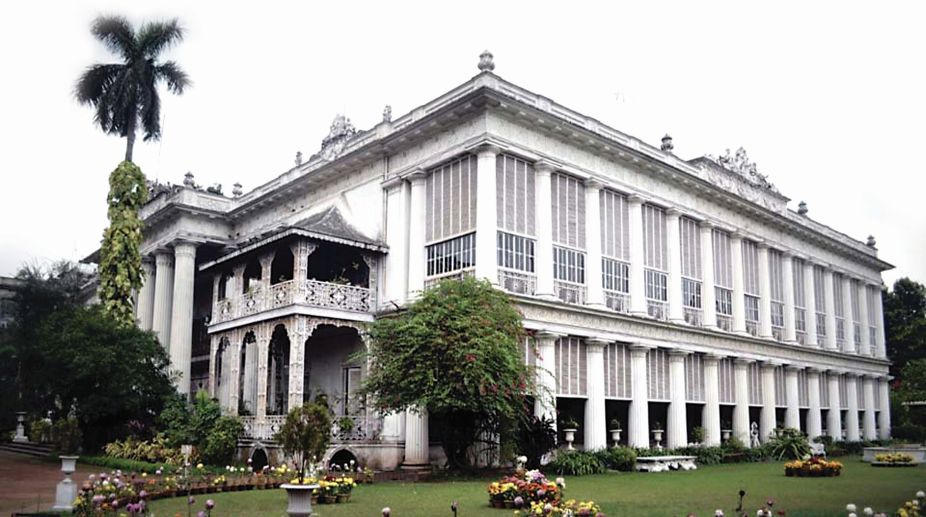Walking amidst heritage in Kolkata
For Calcutta Walks, the agenda has been to enlighten people about the city and its various nuances, which are not much explored.

Marble Palace
The Marble Palace was built in 1835 by Raja Rajendra Mullick – a keen collector of Renaissance art and the house itself has been modelled after the architecture of this eclectic age. Walking through the palatial gates, my friends and I who were on an excursion entered the driveway leading up to the house which was flanked on one side by a lush green lawn that lead to a pond beautifully decorated with marble sculptures of mermaids and mermen.
The premises also include a garden with lawns, a rock garden, a lake and a small zoo.The Marble Palace was built in 1835 by Raja Rajendra Mullick – a keen collector of Renaissance art and the house itself has been modelled after the architecture of this eclectic age.
Walking through the palatial gates, my friends and I who were on an excursion entered the driveway leading up to the house which was flanked on one side by a lush green lawn that lead to a pond beautifully decorated with marble sculptures of mermaids and mermen.
Advertisement
The premises also include a garden with lawns, a rock garden, a lake and a small zoo.Entering the house on a guided tour, we observed the manner in which it stands — a monolith quietly secluded in a lane in North Kolkata, away from the hustle and bustle of the city. Within the premises, the loud tooting of horns and rumble of traffic suddenly gives way to silence as if we are transported back in time to the age of Rajas and royalty.
The temperature drops by a few degrees and combined with the sudden hush in activity creates an atmosphere divergent to the one left outside the gates.True to its name, the house in its grandeur of white marble beckoned us forward to walk through its halls of history and beauty that have frozen time just for a moment so that we can appreciate the work of masters of ages past.
Each room was flanked by marble statues of Greek Gods and Goddesses ranging from Zeus the supreme God of Olympus and Apollo, the Sun God. Satyrs and dancing girls constructed from single blocks of marble were dotted all around the house and along the central courtyard which was surrounded by exotic birds in cages calling out to visitors for freedom or for a closer look- we were not sure.
As we climbed the sturdy winding wooden staircase we were enveloped with even more paintings hailing from the Neo-classical era where sombre men and women watched us as we made our way through the upper quarters of the house.“This is an original Rubens —The Mystical Marriage of Saint Catherine,” said our tour guide snapping us back to reality as we entered a room in which a massive painting hung on the rear wall from floor to ceiling.
The painting was beautiful but time had taken away some of its details staying true to the testament that nothing in life is permanent. However, art has managed to take the impermanence of life and captured it in a moment that is being appreciated centuries later.The walls of this room were decorated with a myriad of paintings illustrating unknown battle scenes dripping with colour and intensity as we progressed down the hall. The intricate inlay of the walls had been decorated with Belgian glass that even to this day gleams as if no time has passed.
We stopped counting the chandeliers suspended from the ceilings after the tenth intricate light fixture shone in the slowly fading light of the day.Walking through the hallways of the house we came across original vases dating back to the Ming dynasty and Japanese paintings that although seem out of place, somehow managed to add more character to this myriad collection of art.
The house almost felt like an organism, brought alive by the art that decorates every surface of it, breathing life into its sculptures as we walked past in amazement at the collective magnificence of the structure itself.The most striking feature of the numerous statues in white marble is that they represent Gods of Greek and Roman mythology.
There are statues of mythological gods like Apollo and Mercury carved in beautifully designed single stone white marble. Apart from the Greek and Roman gods, a massive statue of Queen Victoria dominates the mansion. Constructed from a single piece of mahogany, bronze and marble, the British queen’s patronage by the Raja is evident in the form of numerous statues of in each part of the palace.
Carvings of the statues of Surpanakha (name to be verified) and Laxman placed on top of the ‘Thakur dalan’ are the only pieces of art from the Hindu mythology. The reason behind placing these two figures is that they were the mobilising factors behind the legendry war between Rama and Ravana in the Ramayana.Another attention-puller is the zoo within the premises of the palace.
Although the place is honoured to have the oldest zoo in India, the zoo depicts a clear picture of declining opulence and poor maintenance. Inhabited by a few deer and countable ducks, most of the other cages in the premises are empty.
Walking on the palace grounds, we carried the silence of our surroundings out with us as we made our way home through the chaos of the city. This opportunity was a glimpse into a world unknown and into an era that existed at a time that can only be imagined and written about.
Zara Ryan, Nishat Nizami, Sunayani Manna, Neelanja Acharya Students, SPJS
Advertisement